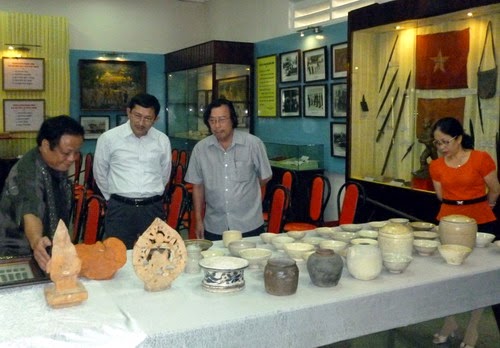Tuesday, July 15, 2014
Saturday, July 12, 2014
Binh Dinh Museum
Binh Dinh Museum
This small museum features exhibits on regional history, just south of the Saigon-Quynhon Hotel on Nguyen Hue, near the intersection with Le Loi. The entry hall focuses on local communism, including an interesting silk print (by Zuy Nhat, 1959) showing a fat French colonist sitting aloft mandarins, in turn supported by bureaucrats, and cruel bosses, with the struggling masses supporting the whole ensemble. The room to the left has a small natural history section and some Cham statues, while the rear room has the bulk of the impressive Cham collection.
Museum-going in Vietnam is pretty hit or miss outside Hanoi or Saigon, but we found this one worth a look. To the right as you enter is a gallery dedicated to the local Communist Party's struggle during the war with American. Some of the objects on display are humorously inconsequential: limepot of heroic war mother Tran Thi Nhi, Radio of heroic war mother Le Thi Dinh, spittoon of heroic war mother Dang Thi Ruong. But among them are some more interesting war objects, especially the photos with legends in English giving a pretty interesting picture of Vietnam's struggles during the war, and more than anything, the Vietnamese government's approach to remembering it -- the South Vietnamese troops are 'puppet soldiers' and Americans are all 'imperialist invaders.' Qui Nhon is also where a large number of South Korean troops landed and fought, in case you forgot that they fought in the war too.
The centre of the gallery is dedicated to the slightly-less interesting French Colonial period, and the gallery on the left features some well-preserved Cham sculpture. In fact, they have so many Cham relics on hand they don't know what to do with them: they are piled in stacks outside the museum. You may take one as a free parting gift.
A total of 165 ancient items, granted by UNESCO center for collection of Vietnamese antiques, has been displayed at the Binh Dinh Museum.
The
unique collection includes 42 Dong Son culture-dated objects, 48 items
originated the Ly-Tran dynasties, 48 coins used under the Tay Son
regime, and other antiques belonging to the pre-Le-Mac dynasties.
The
invaluable antiques not only enhance the value of ancient items but
affirms the significance of Vietnamese traditional value.
Admission is free. Open daily.More details
Nguyen Hue, Qui Nhon
Opening Hours: Summer: 07:00 to 11:00, 14:00 to 17:00 Winter: 7:30 to 11:00, 13:30 to 16:30
Wednesday, July 9, 2014
Queen’s Beach
This stony little beach at the foot of Ganh Rang was once a favourite holiday spot of Queen Nam Phuong. There's a cafe and great views back over Quy Nhon. These two spots make sense to visit together. As you go down An Duong Vuong St south, just past the HAGL Resort, there's a sharp left turn marked by a gate. Admission to the Queen's Beach area is 5,000 dong, 2,000 more for a motorbike. There's a short climb up a paved road to the top of the headland, where sits the tomb of a famous Vietnamese writer, Han Mac Tu. You can stop for a visit, but it's hardly a highlight, unless you're really into Vietnamese literature.
Continuing along, the road leads to the eastern bank of the headland. This is 'Queen's Beach,' named for the wife of Bao Dai, the last king of Vietnam. It's really just a rocky bit of coastline -- we don't know if that's supposed to imply anything about their marriage. There are some cafe's overlooking the water where you can stop for a refreshment, but it's not really a good spot for swimming. You can continue down the road along the headland giving on to the sea for another 2 km -- it makes for a great bike ride or hike -- until you pass through the gate at the bottom of the hill. They may want to see your ticket as you leave, so have it ready. Then you're on Qui Hoa beach, lined with casuarinas trees, and great for swimming. There are some cafes and restaurants along the road, but it's all very peaceful and low key.
(From many sources)
Subscribe to:
Comments (Atom)









